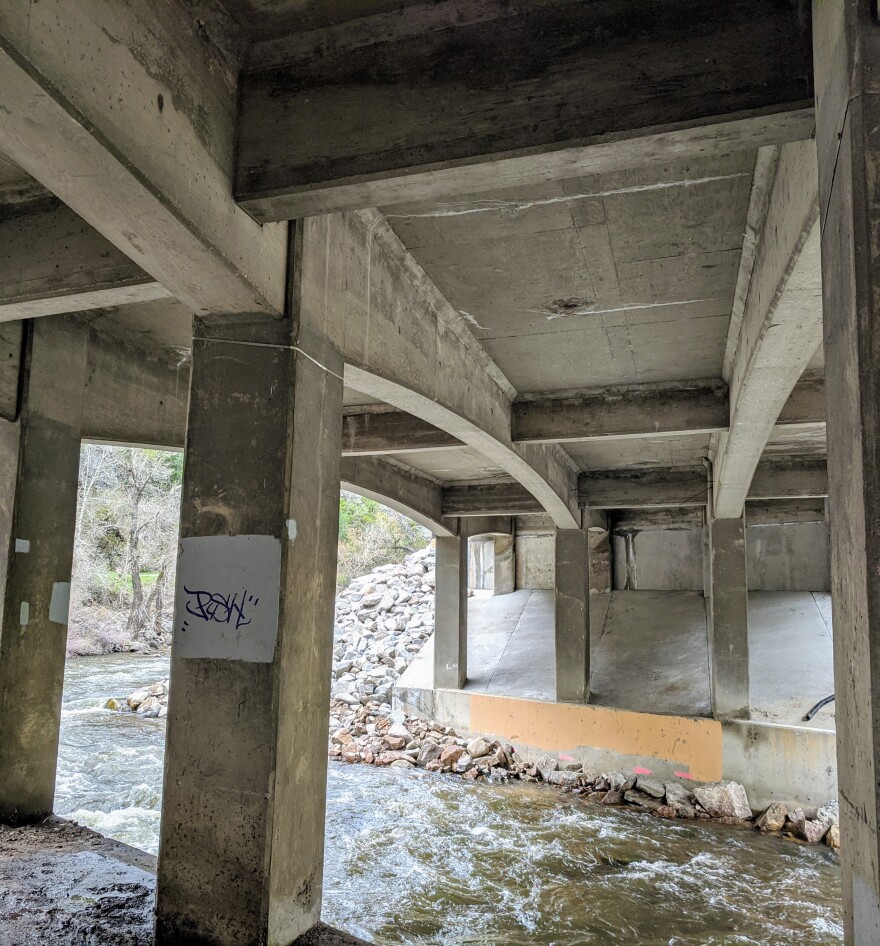A portion of Interstate 70 Denver is now reopened with a new, temporary lane configuration, after being shut down this past weekend. That closure set the stage for the “Mile High Shift” to get underway.
That’s what the Colorado Department of Transportation (CDOT) has dubbed the massive infrastructure project that will divert traffic off of the old, crumbling sections of I-70 in northeast Denver to a new, underground highway that’s been under construction for years. The 57-year-old, structurally insufficient viaduct will be demolished over the next few months.
It’s a significant moment for Colorado’s infrastructure future. But it’s also an interesting moment for the state’s infrastructure past: Colorado Preservation, Inc. recently added 46 historic bridges to their yearly roster of the state’s Most Endangered Places. The move goes a long way towards reframing part of our infrastructure system as historic properties that need protection.
Lisa Schoch is a senior CDOT historian on a mission to boost appreciation for Colorado’s historic bridges. On a recent day, KUNC's Rae Solomon met with Schoch on a pathway underneath the Boulder Creek Bridge, at the 39.10 milepost on State Highway 119. The concrete girder bridge was built in 1953.

“You can't really you can't really see how pretty this bridge is when you're driving and you can just see the deck,” Schoch said. “And if you're down below it, it really does frame the creek very nicely.”
Shoch describes herself as a bridge junkie as well as a historian. But she says Colorado’s bridges don’t tend to have a devoted fan base.
“Colorado doesn't have terribly interesting bridge stock,” she explained. “A lot of our bridges are very functional and they don't look very spectacular. But they look great in their setting. When I was putting together the nomination for most endangered places … I was more struck by how they were placed in the landscape than I was necessarily by the types of bridges. When you look at them in their landscape, I think they're spectacular.”
The way we think about building our physical infrastructure has also changed over time.
”There are a lot of really interesting bridges up until World War II — you have steel through-truss bridges and a lot of interesting actually concrete designs like Luten arches that have a lot of architectural character to them,” Schoch said. In the post-war period, however, standard designs with reinforced, pre-stressed concrete became more prevalent. “We we just weren't thinking about bridges the way we used to.”
Spectacular or not, Schoch says historic bridges are worth preserving because they are part of our state’s cultural heritage.
“Transportation is a huge part of the state and local history. When you think about the construction of the Interstate 70 and how that transformed Colorado … it has so much to do with how communities develop,” she said. “Colorado has one of the most unique transportation systems just because of the mountain engineering.” Building the Eisenhower Tunnel at 11,000 feet was a triumph in itself. “We have the highest point on the interstate system. We have a lot of interesting transportation features. And the bridges are a huge part of that.”
Of course, not all things historic can be preserved. The 83-year-old pony truss Gunnison River Bridge in Delta County is slated for replacement in November 2021. Before the historic structure is removed, CDOT is seeking willing homes for each of its three spans.
“Most of the time we do an archival documentation with photos or we'll do an interpretive sign,” Schoch explained. “But for these bridges that are designed to be moved and repurposed, we advertise them for adoption.”

CDOT has not yet had much success with the bridge adoption program. If no one steps up to adopt the trusses, the bridge will be salvaged for scrap. But Schoch remains hopeful.
“You could use it as a pedestrian bridge, she said. “The deal is if you take it you have to pay for the relocation in most cases. And you also have to rebuild the bridge.”
That kind of investment can make historic bridge adoption a tough sell. Installing a prefabricated bridge is a lot less expensive than rehabilitating a historic bridge. “On the other hand, having a historic bridge on your trail is pretty cool and there's a way to interpret it and make it more interesting for people,” Schoch said.
Schoch makes a strong case for historic bridge preservation. “Some of these bridges that we've replaced over the years — those types are never going to be built again,” she said. “We're losing bridge types over time and they won't ever come back.”
She also hopes that increased awareness of historic bridges could whet public appetite for more thoughtful design in projects Colorado is tackling now. The ultimate goal is to encourage CDOT to think differently about building the infrastructure of the future.





